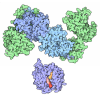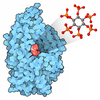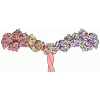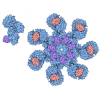[English] 日本語
 Yorodumi
Yorodumi- PDB-8i7o: In situ structure of axonemal doublet microtubules in mouse sperm... -
+ Open data
Open data
- Basic information
Basic information
| Entry | Database: PDB / ID: 8i7o | ||||||
|---|---|---|---|---|---|---|---|
| Title | In situ structure of axonemal doublet microtubules in mouse sperm with 16-nm repeat | ||||||
 Components Components |
| ||||||
 Keywords Keywords | STRUCTURAL PROTEIN / microtubules / axoneme / sperm / filament | ||||||
| Function / homology |  Function and homology information Function and homology informationmale germ-line stem cell population maintenance / axonemal microtubule doublet inner sheath / Microtubule-dependent trafficking of connexons from Golgi to the plasma membrane / Cilium Assembly / Sealing of the nuclear envelope (NE) by ESCRT-III / outer acrosomal membrane / regulation of brood size / establishment of left/right asymmetry / 9+0 motile cilium / axonemal B tubule inner sheath ...male germ-line stem cell population maintenance / axonemal microtubule doublet inner sheath / Microtubule-dependent trafficking of connexons from Golgi to the plasma membrane / Cilium Assembly / Sealing of the nuclear envelope (NE) by ESCRT-III / outer acrosomal membrane / regulation of brood size / establishment of left/right asymmetry / 9+0 motile cilium / axonemal B tubule inner sheath / Intraflagellar transport / axonemal A tubule inner sheath / manchette / Carboxyterminal post-translational modifications of tubulin / protein polyglutamylation / inner dynein arm assembly / positive regulation of feeding behavior / COPI-independent Golgi-to-ER retrograde traffic / sperm principal piece / HSP90 chaperone cycle for steroid hormone receptors (SHR) in the presence of ligand / MAP kinase tyrosine/serine/threonine phosphatase activity / microtubule sliding / regulation of cilium beat frequency involved in ciliary motility / cilium movement involved in cell motility / COPI-mediated anterograde transport / Aggrephagy / protein localization to organelle / Kinesins / 9+2 motile cilium / Mitotic Prometaphase / EML4 and NUDC in mitotic spindle formation / acrosomal membrane / Resolution of Sister Chromatid Cohesion / PKR-mediated signaling / The role of GTSE1 in G2/M progression after G2 checkpoint / RHO GTPases activate IQGAPs / Recycling pathway of L1 / axoneme assembly / COPI-dependent Golgi-to-ER retrograde traffic / axonemal microtubule / RHO GTPases Activate Formins / cilium organization / Separation of Sister Chromatids / Hedgehog 'off' state / Loss of Nlp from mitotic centrosomes / Recruitment of mitotic centrosome proteins and complexes / Loss of proteins required for interphase microtubule organization from the centrosome / Recruitment of NuMA to mitotic centrosomes / Anchoring of the basal body to the plasma membrane / AURKA Activation by TPX2 / Regulation of PLK1 Activity at G2/M Transition / flagellated sperm motility / cell projection organization / MHC class II antigen presentation / protein targeting to membrane / protein targeting to mitochondrion / extrinsic component of membrane / positive regulation of cell motility / tubulin complex / histone H2AXS140 phosphatase activity / RNA polymerase II CTD heptapeptide repeat Y1 phosphatase activity / RNA polymerase II CTD heptapeptide repeat T4 phosphatase activity / RNA polymerase II CTD heptapeptide repeat S2 phosphatase activity / RNA polymerase II CTD heptapeptide repeat S5 phosphatase activity / RNA polymerase II CTD heptapeptide repeat S7 phosphatase activity / MAP kinase serine/threonine phosphatase activity / calmodulin-dependent protein phosphatase activity / myosin phosphatase activity / protein-serine/threonine phosphatase / ciliary base / intercellular bridge / beta-tubulin binding / spermatid development / phosphatase activity / microtubule organizing center / regulation of cell division / mitotic cytokinesis / phosphoprotein phosphatase activity / glial cell projection / sperm flagellum / axoneme / cilium assembly / single fertilization / alpha-tubulin binding / cellular response to unfolded protein / microtubule-based process / cytoplasmic microtubule / sperm midpiece / Neutrophil degranulation / centriole / Hsp70 protein binding / protein-tyrosine-phosphatase / protein tyrosine phosphatase activity, metal-dependent / histone H2AXY142 phosphatase activity / non-membrane spanning protein tyrosine phosphatase activity / cellular response to leukemia inhibitory factor / acrosomal vesicle / ciliary basal body / mitotic spindle organization / Hsp90 protein binding Similarity search - Function | ||||||
| Biological species |  | ||||||
| Method | ELECTRON MICROSCOPY / subtomogram averaging / cryo EM / Resolution: 4.5 Å | ||||||
 Authors Authors | Zhu, Y. / Yin, G.L. / Tai, L.H. / Sun, F. | ||||||
| Funding support |  China, 1items China, 1items
| ||||||
 Citation Citation |  Journal: Cell Discov / Year: 2023 Journal: Cell Discov / Year: 2023Title: In-cell structural insight into the stability of sperm microtubule doublet. Authors: Linhua Tai / Guoliang Yin / Xiaojun Huang / Fei Sun / Yun Zhu /  Abstract: The propulsion for mammalian sperm swimming is generated by flagella beating. Microtubule doublets (DMTs) along with microtubule inner proteins (MIPs) are essential structural blocks of flagella. ...The propulsion for mammalian sperm swimming is generated by flagella beating. Microtubule doublets (DMTs) along with microtubule inner proteins (MIPs) are essential structural blocks of flagella. However, the intricate molecular architecture of intact sperm DMT remains elusive. Here, by in situ cryo-electron tomography, we solved the in-cell structure of mouse sperm DMT at 4.5-7.5 Å resolutions, and built its model with 36 kinds of MIPs in 48 nm periodicity. We identified multiple copies of Tektin5 that reinforce Tektin bundle, and multiple MIPs with different periodicities that anchor the Tektin bundle to tubulin wall. This architecture contributes to a superior stability of A-tubule than B-tubule of DMT, which was revealed by structural comparison of DMTs from the intact and deformed axonemes. Our work provides an overall molecular picture of intact sperm DMT in 48 nm periodicity that is essential to understand the molecular mechanism of sperm motility as well as the related ciliopathies. | ||||||
| History |
|
- Structure visualization
Structure visualization
| Structure viewer | Molecule:  Molmil Molmil Jmol/JSmol Jmol/JSmol |
|---|
- Downloads & links
Downloads & links
- Download
Download
| PDBx/mmCIF format |  8i7o.cif.gz 8i7o.cif.gz | 11.4 MB | Display |  PDBx/mmCIF format PDBx/mmCIF format |
|---|---|---|---|---|
| PDB format |  pdb8i7o.ent.gz pdb8i7o.ent.gz | Display |  PDB format PDB format | |
| PDBx/mmJSON format |  8i7o.json.gz 8i7o.json.gz | Tree view |  PDBx/mmJSON format PDBx/mmJSON format | |
| Others |  Other downloads Other downloads |
-Validation report
| Summary document |  8i7o_validation.pdf.gz 8i7o_validation.pdf.gz | 10.1 MB | Display |  wwPDB validaton report wwPDB validaton report |
|---|---|---|---|---|
| Full document |  8i7o_full_validation.pdf.gz 8i7o_full_validation.pdf.gz | 12.6 MB | Display | |
| Data in XML |  8i7o_validation.xml.gz 8i7o_validation.xml.gz | 2 MB | Display | |
| Data in CIF |  8i7o_validation.cif.gz 8i7o_validation.cif.gz | 2.8 MB | Display | |
| Arichive directory |  https://data.pdbj.org/pub/pdb/validation_reports/i7/8i7o https://data.pdbj.org/pub/pdb/validation_reports/i7/8i7o ftp://data.pdbj.org/pub/pdb/validation_reports/i7/8i7o ftp://data.pdbj.org/pub/pdb/validation_reports/i7/8i7o | HTTPS FTP |
-Related structure data
| Related structure data |  35229MC  8i7rC C: citing same article ( M: map data used to model this data |
|---|---|
| Similar structure data | Similarity search - Function & homology  F&H Search F&H Search |
- Links
Links
- Assembly
Assembly
| Deposited unit | 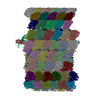
|
|---|---|
| 1 |
|
- Components
Components
-Protein , 19 types, 179 molecules A2A3AEAGAIBEBGBICGCIDEDGEEEGFEFGGEGGGIHEHGHIIEIGIIJEJGKEKGKI...
| #1: Protein | Mass: 48713.035 Da / Num. of mol.: 2 / Source method: isolated from a natural source / Source: (natural)  #2: Protein | Mass: 48689.090 Da / Num. of mol.: 61 / Source method: isolated from a natural source / Source: (natural)  #3: Protein | Mass: 47897.918 Da / Num. of mol.: 62 / Source method: isolated from a natural source / Source: (natural)  #4: Protein | Mass: 50385.066 Da / Num. of mol.: 4 / Source method: isolated from a natural source / Source: (natural)  #5: Protein | Mass: 56754.777 Da / Num. of mol.: 7 / Source method: isolated from a natural source / Source: (natural)  #6: Protein | Mass: 52121.449 Da / Num. of mol.: 6 / Source method: isolated from a natural source / Source: (natural)  #7: Protein | Mass: 23987.262 Da / Num. of mol.: 2 / Source method: isolated from a natural source / Source: (natural)  #8: Protein | Mass: 62817.535 Da / Num. of mol.: 8 / Source method: isolated from a natural source / Source: (natural)  #11: Protein | Mass: 36659.566 Da / Num. of mol.: 2 / Source method: isolated from a natural source / Source: (natural)  #12: Protein | Mass: 23097.957 Da / Num. of mol.: 2 / Source method: isolated from a natural source / Source: (natural)  #13: Protein | Mass: 21527.574 Da / Num. of mol.: 2 / Source method: isolated from a natural source / Source: (natural)  References: UniProt: Q9D9D8, protein-serine/threonine phosphatase, protein-tyrosine-phosphatase #14: Protein | Mass: 57406.484 Da / Num. of mol.: 3 / Source method: isolated from a natural source / Source: (natural)  #15: Protein | Mass: 29587.521 Da / Num. of mol.: 2 / Source method: isolated from a natural source / Source: (natural)  #16: Protein | Mass: 16305.608 Da / Num. of mol.: 2 / Source method: isolated from a natural source / Source: (natural)  #18: Protein | Mass: 20575.123 Da / Num. of mol.: 2 / Source method: isolated from a natural source / Source: (natural)  #20: Protein | Mass: 176028.312 Da / Num. of mol.: 2 / Source method: isolated from a natural source / Source: (natural)  #21: Protein | | Mass: 32786.020 Da / Num. of mol.: 1 / Source method: isolated from a natural source / Source: (natural)  #23: Protein | Mass: 27763.268 Da / Num. of mol.: 3 / Source method: isolated from a natural source / Source: (natural)  #24: Protein | Mass: 19512.373 Da / Num. of mol.: 6 / Source method: isolated from a natural source / Source: (natural)  |
|---|
-EF-hand domain-containing ... , 2 types, 3 molecules G1G2G5
| #9: Protein | Mass: 75235.422 Da / Num. of mol.: 2 / Source method: isolated from a natural source / Source: (natural)  #10: Protein | | Mass: 87758.023 Da / Num. of mol.: 1 / Source method: isolated from a natural source / Source: (natural)  |
|---|
-Cilia- and flagella-associated protein ... , 3 types, 7 molecules N2N3P1P2XCXDXE
| #17: Protein | Mass: 18960.092 Da / Num. of mol.: 2 / Source method: isolated from a natural source / Source: (natural)  #19: Protein | Mass: 68322.164 Da / Num. of mol.: 2 / Source method: isolated from a natural source / Source: (natural)  #22: Protein | Mass: 22781.389 Da / Num. of mol.: 3 / Source method: isolated from a natural source / Source: (natural)  |
|---|
-Non-polymers , 1 types, 123 molecules 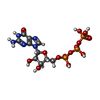
| #25: Chemical | ChemComp-GTP / |
|---|
-Details
| Has ligand of interest | N |
|---|
-Experimental details
-Experiment
| Experiment | Method: ELECTRON MICROSCOPY |
|---|---|
| EM experiment | Aggregation state: CELL / 3D reconstruction method: subtomogram averaging |
- Sample preparation
Sample preparation
| Component | Name: mouse sperm / Type: CELL / Entity ID: #1-#24 / Source: NATURAL |
|---|---|
| Source (natural) | Organism:  |
| Buffer solution | pH: 7 |
| Specimen | Embedding applied: NO / Shadowing applied: NO / Staining applied: NO / Vitrification applied: YES |
| Vitrification | Cryogen name: ETHANE |
- Electron microscopy imaging
Electron microscopy imaging
| Experimental equipment |  Model: Titan Krios / Image courtesy: FEI Company |
|---|---|
| Microscopy | Model: FEI TITAN KRIOS |
| Electron gun | Electron source:  FIELD EMISSION GUN / Accelerating voltage: 300 kV / Illumination mode: SPOT SCAN FIELD EMISSION GUN / Accelerating voltage: 300 kV / Illumination mode: SPOT SCAN |
| Electron lens | Mode: BRIGHT FIELD / Nominal defocus max: 5000 nm / Nominal defocus min: 1000 nm / Cs: 2.7 mm |
| Image recording | Electron dose: 3 e/Å2 / Avg electron dose per subtomogram: 117 e/Å2 / Detector mode: SUPER-RESOLUTION / Film or detector model: GATAN K2 QUANTUM (4k x 4k) |
- Processing
Processing
| Software | Name: UCSF ChimeraX / Version: 1.6/v9 / Classification: model building / URL: https://www.rbvi.ucsf.edu/chimerax/ / Os: Windows / Type: package |
|---|---|
| CTF correction | Type: PHASE FLIPPING AND AMPLITUDE CORRECTION |
| Symmetry | Point symmetry: C1 (asymmetric) |
| 3D reconstruction | Resolution: 4.5 Å / Resolution method: FSC 0.143 CUT-OFF / Num. of particles: 37018 / Symmetry type: POINT |
| EM volume selection | Num. of tomograms: 689 / Num. of volumes extracted: 37018 |
 Movie
Movie Controller
Controller

















 PDBj
PDBj




